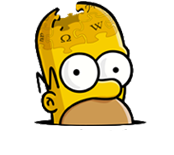
Difference between revisions of "Wikisimpsons:Manual of Style"
Wikisimpsons - The Simpsons Wiki
(→Credits) |
|||
| Line 1: | Line 1: | ||
| − | + | This is an instruction manual that addresses the conventions adopted by Wikisimpsons in writing, titles, articles, and linking. Please read it before you contribute to Wikisimpsons. | |
| + | ==Basic wikicode== | ||
| + | |||
| + | Contributors are expected to use decent spelling and grammar and a basic level of wikicode. Some of the most commonly used aspects of wikicode are listed below. | ||
| + | |||
| + | *Text formatting: To make text bold, put three apostrophes on either side of it, such as <code><nowiki>'''Homer'''</nowiki></code>. This will result in '''Homer'''. However, bold text is mostly used to define the name of the subject matter at the start of an article or for any notes which need a very large amount of emphasis. For a normal emphasis, it is common style to put text in italics, which is done with two apostrophes instead of three, such as <code><nowiki>''Homer''</nowiki></code>. This will result in ''Homer''. | ||
| + | |||
| + | *Links: Whenever something else is referenced in an article which has its own article on Wikisimpsons, be sure to link to it. This is done by putting two brackets on either side of a word. For example, <code><nowiki>[[Bart]]</nowiki></code> will result in [[Bart]]. However, sometimes there's no way to use the exact name of an article in a sentence without the sentence being awkwardly-worded. In these instances, to have different text display than the article's name, put a vertical pipe between the article's name and the text you would like to display. For example, <code><nowiki>[[Homer|Bart's Dad]]</nowiki></code> will result in [[Homer|Bart's Dad]], which you may notice links to the Homer article. | ||
| + | **Wikipedia links: When something is referenced outside of the Simpson universe, it is often useful to link to the Wikipedia article on the subject. When linking to a Wikipedia subject, simply put the word "wikipedia:" before the article's name. However, be careful that this doesn't show up in the link text itself, and be sure to check to see if you're linking to an existing Wikipedia article. As an example, to link to the Wikipedia article on The Simpsons, typing <code><nowiki>[[wikipedia:The Simpsons|The Simpsons]]</nowiki></code> would result in [[wikipedia:The Simpsons|The Simpsons]]. | ||
| + | **External links: Other links can be done with using a single bracket. In this instance, a vertical line is not necessary to divide the name from the link. However, the full address is needed to link to a page. For example, to link to the Simpsons website, typing <code><nowiki>[http://www.simpsons.com/ The Simpsons website]</nowiki></code> would result in [http://www.simpsons.com/ The simpsons wmebsite]. External links are primarily used to cite references and to link to any related websites. | ||
| + | *Headlines: Articles are divided by levels of headlines, much like a large outline. These are indicated by equals signs on either side of the headline text. There are six levels of headlines, with one equals sign being the first and highest level, which would look like <code><nowiki>=Headline text=</nowiki></code>, and six equals signs being the sixth and lowest level, which would look like <code><nowiki>======Headline text======</nowiki></code>. First and second level headlines are underlined. Text size decreases with lower level headlines. | ||
| + | *Images: Images are added in a manner similar to links. To add in an image, link to the image's name, but add in "Image:" before the name. For example, <code><nowiki>[[Image:Homer Simpson.png]]</nowiki></code> would add an image of Homer to the article. Formatting attributes can be added to an image as well, divided with vertical lines. For example, <code><nowiki>[[Image:Homer Simpson.png|thumb|100px|right|Homer]]</nowiki></code> will add the image to the right. | ||
| + | *Categories: Categories are also added in a manner similar to Links. To categorize an article, link to the category's name, but add in "Category:" before the name. For example, <code><nowiki>[[Category:Characters]]</nowiki></code> would add this article to Category:Characters. To link to a category and not add the article to the category, add in an extra colon before the name, like [[:Category:Characters]], all pages should be categorised. | ||
| + | *Lists: There are two major ways to do lists. | ||
| + | **Bulleted lists: To create a bulleted list, put an asterisk before each item. For example: | ||
| + | |||
| + | * Homer | ||
| + | * Marge | ||
| + | * Bart | ||
| + | * Lisa | ||
| + | |||
| + | will make | ||
| + | |||
| + | * Homer | ||
| + | * Marge | ||
| + | * Bart | ||
| + | * Lisa | ||
| + | **Definition lists: To create a list with definitions, put a semicolon before each item, and a colon before the details on each item. For example: | ||
| + | |||
| + | ; Homer | ||
| + | : Stupid | ||
| + | ; Marge | ||
| + | : Kind | ||
| + | ; Bart | ||
| + | : Naughty | ||
| + | ; Lisa | ||
| + | : Smart | ||
| + | |||
| + | will result in | ||
| + | ; Homer | ||
| + | : Stupid | ||
| + | ; Marge | ||
| + | : Kind | ||
| + | ; Bart | ||
| + | : Naughty | ||
| + | ; Lisa | ||
| + | : Smart | ||
| + | |||
| + | |||
| + | |||
==Episode== | ==Episode== | ||
===Main Article=== | ===Main Article=== | ||
Revision as of 04:03, January 14, 2010
This is an instruction manual that addresses the conventions adopted by Wikisimpsons in writing, titles, articles, and linking. Please read it before you contribute to Wikisimpsons.
Contents
Basic wikicode
Contributors are expected to use decent spelling and grammar and a basic level of wikicode. Some of the most commonly used aspects of wikicode are listed below.
- Text formatting: To make text bold, put three apostrophes on either side of it, such as
'''Homer'''. This will result in Homer. However, bold text is mostly used to define the name of the subject matter at the start of an article or for any notes which need a very large amount of emphasis. For a normal emphasis, it is common style to put text in italics, which is done with two apostrophes instead of three, such as''Homer''. This will result in Homer.
- Links: Whenever something else is referenced in an article which has its own article on Wikisimpsons, be sure to link to it. This is done by putting two brackets on either side of a word. For example,
[[Bart]]will result in Bart. However, sometimes there's no way to use the exact name of an article in a sentence without the sentence being awkwardly-worded. In these instances, to have different text display than the article's name, put a vertical pipe between the article's name and the text you would like to display. For example,[[Homer|Bart's Dad]]will result in Bart's Dad, which you may notice links to the Homer article.- Wikipedia links: When something is referenced outside of the Simpson universe, it is often useful to link to the Wikipedia article on the subject. When linking to a Wikipedia subject, simply put the word "wikipedia:" before the article's name. However, be careful that this doesn't show up in the link text itself, and be sure to check to see if you're linking to an existing Wikipedia article. As an example, to link to the Wikipedia article on The Simpsons, typing
[[wikipedia:The Simpsons|The Simpsons]]would result in The Simpsons. - External links: Other links can be done with using a single bracket. In this instance, a vertical line is not necessary to divide the name from the link. However, the full address is needed to link to a page. For example, to link to the Simpsons website, typing
[http://www.simpsons.com/ The Simpsons website]would result in The simpsons wmebsite. External links are primarily used to cite references and to link to any related websites.
- Wikipedia links: When something is referenced outside of the Simpson universe, it is often useful to link to the Wikipedia article on the subject. When linking to a Wikipedia subject, simply put the word "wikipedia:" before the article's name. However, be careful that this doesn't show up in the link text itself, and be sure to check to see if you're linking to an existing Wikipedia article. As an example, to link to the Wikipedia article on The Simpsons, typing
- Headlines: Articles are divided by levels of headlines, much like a large outline. These are indicated by equals signs on either side of the headline text. There are six levels of headlines, with one equals sign being the first and highest level, which would look like
=Headline text=, and six equals signs being the sixth and lowest level, which would look like======Headline text======. First and second level headlines are underlined. Text size decreases with lower level headlines. - Images: Images are added in a manner similar to links. To add in an image, link to the image's name, but add in "Image:" before the name. For example,
[[Image:Homer Simpson.png]]would add an image of Homer to the article. Formatting attributes can be added to an image as well, divided with vertical lines. For example,[[Image:Homer Simpson.png|thumb|100px|right|Homer]]will add the image to the right. - Categories: Categories are also added in a manner similar to Links. To categorize an article, link to the category's name, but add in "Category:" before the name. For example,
[[Category:Characters]]would add this article to Category:Characters. To link to a category and not add the article to the category, add in an extra colon before the name, like Category:Characters, all pages should be categorised. - Lists: There are two major ways to do lists.
- Bulleted lists: To create a bulleted list, put an asterisk before each item. For example:
* Homer * Marge * Bart * Lisa
will make
- Homer
- Marge
- Bart
- Lisa
- Definition lists: To create a list with definitions, put a semicolon before each item, and a colon before the details on each item. For example:
; Homer : Stupid ; Marge : Kind ; Bart : Naughty ; Lisa : Smart
will result in
- Homer
- Stupid
- Marge
- Kind
- Bart
- Naughty
- Lisa
- Smart
Episode
Main Article
- Tabs on the top
- Template
- A general summary of when released and a basic plot
- A Synopsis
- Reception
- References
- Season Template
References
- Tab
- Trivia
- Error
- Cultural References
- Production
- Season Reference Template
Appearances
- Tab
- Character Appearances, in gallery format, in order of appearance
- Vehicle Appearances, in gallery format, in order of appearance
- Location appearances, in gallery format, in order of appearance
- Misc appearances, in gallery format, in order of appearance
- season appearance template
Credits
See Wikisimpsons:Manual of Style/Credits
Quotes
- tab
- Notable quotes
- Quote template
